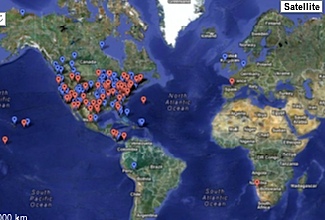| Strategic Vision |
Field Stations and Marine Laboratories of the Future
Biological field stations and marine labs have been centers of environmental science for a century—the places where scientists go to study environmental processes in their natural context. They are crucibles of innovation and discovery, storehouses of increasingly critical historical information, and hubs of integrated research; they have the infrastructure to support complex experiments and to maintain long-term projects. Field stations and marine labs (FSMLs) host thousands of individual scientists and work behind the scenes in many of the nation’s environmental initiatives. The hundreds of sites that support sustained place-based environmental research are a tremendous resource for understanding and managing dramatic environmental change—but one that remains largely untapped at the national level. The Organization of Biological Field Stations (OBFS) and the National Association of Marine Laboratories (NAML) have produced a report to help FSMLs meet the dynamic and changing needs of scientists, students, and the public they serve: Field Stations and Marine Laboratories of the Future: A Strategic Vision The report takes advantage of ideas generated through a national workshop OBFS and NAML’s primary recommendation is to create a Network Center to catalyze broader-scale science and facilitate participation in coordinated national and international environmental efforts. As part of the planning effort OBFS and NAML recognized the importance of managing environmental data to moving science forward. Towards that end an initial review of initiatives involved in the management of environmental data, along with other scientific disciplines focused on data management within complex systems, was conducted: This material is based upon work supported by the National Science Foundation under Grant No. DBI-1126161. Any opinions, findings, and conclusions or recommendations expressed in this material are those of the author(s) and do not necessarily reflect the views of the National Science Foundation (NSF). The National Association of Marine Laboratories (NAML), organized in the late 1980's, is a nonprofit organization of over 120 members employing more than 10,000 scientists, engineers, and professionals and representing marine and Great Lakes laboratories stretching from Guam to Bermuda and Alaska to Puerto Rico. The member institutions of the National Association of Marine Labs work together to improve the quality and effectiveness of ocean, coastal and Great Lakes research, education and outreach. Through these unique national and regional networks, NAML encourages ecosystem-based management, wise local land management and the understanding and protection of natural resources.
The Organization of Biological Field Stations (OBFS) is a 501(c)(3) nonprofit that represents field stations throughout the world. The mission of OBFS is to help member stations increase their effectiveness in supporting critical research, education, and outreach programs. OBFS pursues this goal in a manner that maximizes diversity, inclusiveness, sustainability, and transparency.
|


